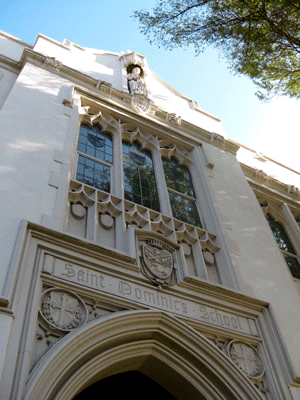
St. Dominic's School was dedicated in 1929.
St. Dominic’s School closed for the final time at the end of the school year after more than a century of educating economically disadvantaged children in the neighborhood.
Yet the future for both the school and its Gothic home on Pine Street, erected in 1929, seems filled with promise.
The school has been known as the Megan Furth Catholic Academy, for a major donor, since it merged a few years ago with the Fillmore’s Sacred Heart School, rescuing both from probable closure. Yet even as St. Dominic’s Church leaders increased enrollment and steered the independent school in a more dynamic direction — at a rent of $1 per year — they’ve had their eyes on the building, which sits next door in the church’s parking lot.
Now another merger is in the works. The school will join forces with Mission Dolores School, another endangered Catholic school with declining enrollment, which happens to have an expansive and historic home next to Mission Dolores.
And the church gets control of the school building, which it plans to transform into a new parish hall and community center.
“It’s a win-win-win,” says Father Xavier Lavagetto, pastor of St. Dominic’s.
The new Mission Dolores Academy will open this fall with 250 students in kindergarten through eighth grade — including almost all of St. Dominic’s students. They’ll have an auditorium, a gymnasium — even a playground without cars parked in it — plus a new computerized learning program.
“While it’s super sad not to have them here, the possibilities are just magical,” says Father Xavier. “Our school looks like a toy school compared to theirs. What’s being created is a wonderful opportunity for the kids.”
At a time when churches have been shrinking, St. Dominic’s is one of the few parishes in the city — or the nation — that is growing. “We were down to 18 kids in the church in 2000,” says Father Xavier, “and now we’ve got 90-plus. There’s been a real rejuvenation.” Adult education and community programs such as Alcoholics Anonymous are also growing. As a result, the church needs more space.
For now, existing programs will begin using the school’s former classrooms while renovations are considered and costs are estimated. Then fund-raising will begin.
After the 1989 earthquake, St. Dominic’s raised $7.2 million for a seismic retrofit, which included the addition of nine flying buttresses. Then a decade-long restoration campaign, only recently completed, raised more than $11 million to repair exterior masonry, replace interior furnishings and restore the church’s many gloriously colored stained glass windows.
“We’re trying to give people a little bit of a break,” says Father Xavier. But he hopes an improving economy will make it possible for the transformation of the school building to begin in 2012.
“I think it’ll be good for the whole neighborhood,” he says, with an eventual goal of removing the modular classrooms beside the school and the cyclone fence surrounding the parking lot, then landscaping it into a more park-like setting.
In 1863, the Dominican friars paid $6,000 for the city block bounded by Steiner, Bush, Pierce and Pine Streets, founding the first St. Dominic’s Church in 1873.
“The Dominicans have been here for nearly 150 years,” says Father Xavier, “and we want to be here for another 150 years.”

St. Dominic's School sits beside the church facing Pine Street.
Filed under: Landmarks, Neighborhood History





